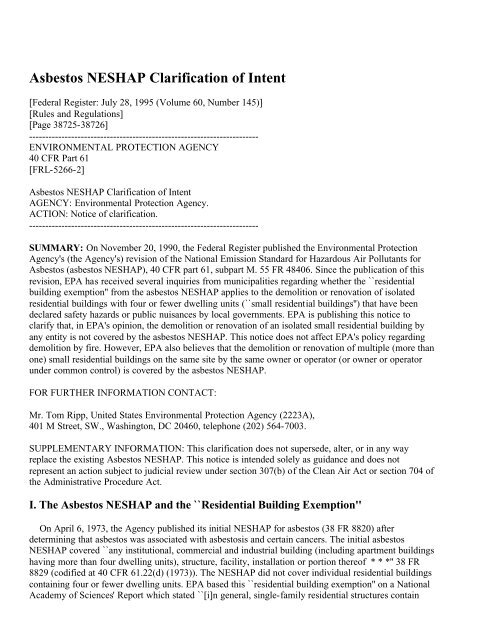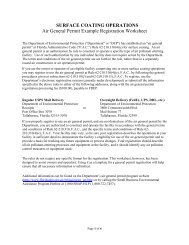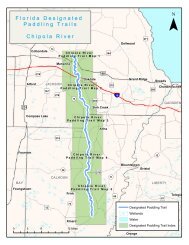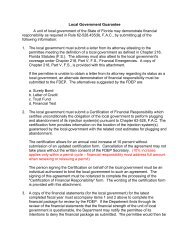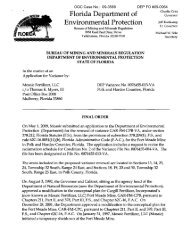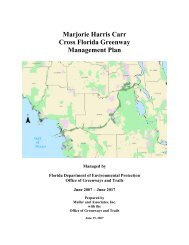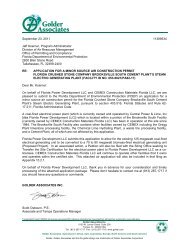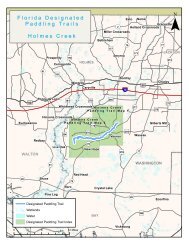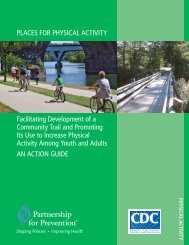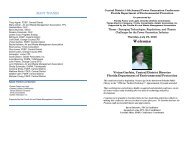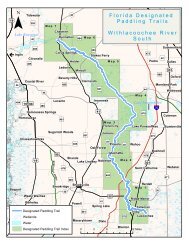Asbestos NESHAP Clarification of Intent - Florida Department of ...
Asbestos NESHAP Clarification of Intent - Florida Department of ...
Asbestos NESHAP Clarification of Intent - Florida Department of ...
Create successful ePaper yourself
Turn your PDF publications into a flip-book with our unique Google optimized e-Paper software.
<strong>Asbestos</strong> <strong>NESHAP</strong> <strong>Clarification</strong> <strong>of</strong> <strong>Intent</strong>[Federal Register: July 28, 1995 (Volume 60, Number 145)][Rules and Regulations][Page 38725-38726]-----------------------------------------------------------------------ENVIRONMENTAL PROTECTION AGENCY40 CFR Part 61[FRL-5266-2]<strong>Asbestos</strong> <strong>NESHAP</strong> <strong>Clarification</strong> <strong>of</strong> <strong>Intent</strong>AGENCY: Environmental Protection Agency.ACTION: Notice <strong>of</strong> clarification.-----------------------------------------------------------------------SUMMARY: On November 20, 1990, the Federal Register published the Environmental ProtectionAgency's (the Agency's) revision <strong>of</strong> the National Emission Standard for Hazardous Air Pollutants for<strong>Asbestos</strong> (asbestos <strong>NESHAP</strong>), 40 CFR part 61, subpart M. 55 FR 48406. Since the publication <strong>of</strong> thisrevision, EPA has received several inquiries from municipalities regarding whether the ``residentialbuilding exemption'' from the asbestos <strong>NESHAP</strong> applies to the demolition or renovation <strong>of</strong> isolatedresidential buildings with four or fewer dwelling units (``small residential buildings'') that have beendeclared safety hazards or public nuisances by local governments. EPA is publishing this notice toclarify that, in EPA's opinion, the demolition or renovation <strong>of</strong> an isolated small residential building byany entity is not covered by the asbestos <strong>NESHAP</strong>. This notice does not affect EPA's policy regardingdemolition by fire. However, EPA also believes that the demolition or renovation <strong>of</strong> multiple (more thanone) small residential buildings on the same site by the same owner or operator (or owner or operatorunder common control) is covered by the asbestos <strong>NESHAP</strong>.FOR FURTHER INFORMATION CONTACT:Mr. Tom Ripp, United States Environmental Protection Agency (2223A),401 M Street, SW., Washington, DC 20460, telephone (202) 564-7003.SUPPLEMENTARY INFORMATION: This clarification does not supersede, alter, or in any wayreplace the existing <strong>Asbestos</strong> <strong>NESHAP</strong>. This notice is intended solely as guidance and does notrepresent an action subject to judicial review under section 307(b) <strong>of</strong> the Clean Air Act or section 704 <strong>of</strong>the Administrative Procedure Act.I. The <strong>Asbestos</strong> <strong>NESHAP</strong> and the ``Residential Building Exemption''On April 6, 1973, the Agency published its initial <strong>NESHAP</strong> for asbestos (38 FR 8820) afterdetermining that asbestos was associated with asbestosis and certain cancers. The initial asbestos<strong>NESHAP</strong> covered ``any institutional, commercial and industrial building (including apartment buildingshaving more than four dwelling units), structure, facility, installation or portion there<strong>of</strong> * * *'' 38 FR8829 (codified at 40 CFR 61.22(d) (1973)). The <strong>NESHAP</strong> did not cover individual residential buildingscontaining four or fewer dwelling units. EPA based this ``residential building exemption'' on a NationalAcademy <strong>of</strong> Sciences' Report which stated ``[i]n general, single-family residential structures contain
only small amounts <strong>of</strong> asbestos insulation.'' EPA stated that apartment houses with four or fewerdwelling units were considered to be equivalent to single-family residential structures. 38 FR 8821.Since that time, EPA has revised the asbestos <strong>NESHAP</strong> on several occasions. EPA has notsubstantially revised the exemption for small residential buildings. However, EPA has stated thatresidential buildings demolished or renovated as part <strong>of</strong> larger projects, for instance, highwayconstruction projects, were not exempt from the <strong>NESHAP</strong>. See Letter from John S. Seitz, Director,Stationary Source Compliance Division, U.S. EPA to Thomas S. Hadden, Supervisor, Division <strong>of</strong> AirPollution Control, Ohio EPA, dated March 15, 1989; letter from Ann Pontius, U.S. EPA Region 5 toThomas Hadden, dated September 28, 1988; letter from David Kee, Air Section, U.S. EPA to RichardLarson, Minneapolis Housing and Redevelopment Authority, dated May 16, 1973.II. The 1990 Revisions to the <strong>Asbestos</strong> <strong>NESHAP</strong>On November 20, 1990, EPA published a revision to the asbestos <strong>NESHAP</strong>. 55 FR 48406. Thepurpose <strong>of</strong> the revision was ``to enhance enforcement and promote compliance with the current standardwithout altering the stringency <strong>of</strong> existing controls.'' Id. The revisions revised and added severaldefinitions in order to clarify the requirements <strong>of</strong> the <strong>NESHAP</strong>. The preamble accompanying therevisions also contained clarifying information.In particular, the 1990 revisions clarified the definition <strong>of</strong> ``facility'' to include:Any institutional, commercial, public, industrial, or residential structure, installation, orbuilding (including any structure, installation or building containing condominiums orindividual dwelling units operated as a residential cooperative, but excluding residentialbuildings having four or fewer dwelling units) * * *The 1990 amendments also added a definition <strong>of</strong> ``installation'' that stated:Installation means any building or structure or any group <strong>of</strong> buildings or structures at asingle demolition or renovation site that are under the control <strong>of</strong> the same owner oroperator (or owner or operator under common control).Id. (codified at 40 CFR 61.141). In responding to comments regarding the ``residential buildingexemption,'' the preamble noted that:EPA does not consider residential structures that are demolished as part <strong>of</strong> a commercialor public project to be exempt from this rule. For example, the demolition <strong>of</strong> one or morehouses as part <strong>of</strong> an urban renewal project, a highway construction project, or a projectto develop a shopping mall, industrial facility, or other private development would besubject to the <strong>NESHAP</strong>. * * * The owner <strong>of</strong> a home that renovates his house ordemolishes it to construct another house is not to be subject to the <strong>NESHAP</strong>.Id. at 48412. 1 Further, in response to a comment asking whether a group <strong>of</strong> residential buildings at onelocation would be covered by the rule, the preamble stated:A group <strong>of</strong> residential buildings under the control <strong>of</strong> the same owner or operator isconsidered an installation according to the definition <strong>of</strong> ``installation'' and is thereforecovered by the rule.
III. Programs to Demolish or Renovate Residential BuildingsSince the publication <strong>of</strong> the 1990 revisions to the asbestos <strong>NESHAP</strong>, certain questions have arisenregarding whether demolitions or renovations <strong>of</strong> residential homes that are demolished or renovated bymunicipalities for reasons <strong>of</strong> public health, welfare or safety (``nuisance abatement demolitions'') arecovered by the asbestos <strong>NESHAP</strong>. 2 Several municipalities have stated that they believe suchdemolitions or renovations to be excluded from the <strong>NESHAP</strong> under the residential building exemption.Municipalities have also stated that EPA <strong>of</strong>ficials have been inconsistent in their determinations <strong>of</strong> thisissue. In particular, <strong>of</strong>ficials from several municipalities in <strong>Florida</strong> have asked EPA to issue a noticeclarifying EPA's interpretation <strong>of</strong> the asbestos <strong>NESHAP</strong> with regard to this issue. In addition, the House<strong>of</strong> Representatives Report accompanying H.R. 4624 (House Report 103-555, reported by the HouseAppropriations Committee), also noted these allegedly inconsistent interpretations and directed EPA toissue a notice <strong>of</strong> clarification that a nuisance abatement demolition or renovation does not subject anotherwise exempt structure to the asbestos <strong>NESHAP</strong> regulations. In an effort to clarify this issue for theregulated community, EPA is presenting this notice giving its interpretation <strong>of</strong> the <strong>NESHAP</strong> with regardto this issue.IV. EPA InterpretationEPA believes that individual small residential buildings that are demolished or renovated are notcovered by the asbestos <strong>NESHAP</strong>. This is true whether the demolition or renovation is performed byagents <strong>of</strong> the owner <strong>of</strong> the property or whether the demolition or renovation is performed by agents <strong>of</strong>the municipality. EPA believes that the residential building exemption applies equally to an individualsmall residential building regardless <strong>of</strong> whether a municipality is an ``owner or operator'' for thepurposes <strong>of</strong> the demolition or renovation. EPA believes that the exemption is based on the type <strong>of</strong>building being demolished or renovated and the type <strong>of</strong> demolition or renovation project that is beingundertaken, not the entity performing or controlling the demolition or renovation. However, EPAbelieves that the residential building exemption does not apply where multiple (more than one) smallresidential buildings on the same site 3 are demolished or renovated by the same owner or operator aspart <strong>of</strong> the same project or where a single residential building is demolished or renovated as part <strong>of</strong> alarger project that includes demolition or renovation <strong>of</strong> non-residential buildings. The definition <strong>of</strong>facility specifically includes ``any residential structure, installation or building'' but excludes only``residential buildings having four or fewer dwelling units'' [emphasis added]. Id. at 48415. Specificallynot excluded from the definition <strong>of</strong> facility were residential installations. EPA believes that the fact thatthe residential building exemption is limited to residential buildings, and does not include residentialinstallations, shows that the residential building exemption was not designed to exempt from the<strong>NESHAP</strong> demolitions or renovations <strong>of</strong> multiple buildings at a single site by the same owner oroperator. Moreover, to the extent the regulations are ambiguous, EPA believes the language <strong>of</strong> thepreamble to the 1990 regulations quoted above makes clear that the Agency interpreted the residentialbuilding exemption not to include the demolition <strong>of</strong> a group <strong>of</strong> residential buildings on the same siteunder the control <strong>of</strong> the same owner or operator. The preamble also notes that demolitions <strong>of</strong> residentialbuildings as a part <strong>of</strong> larger demolition projects (e.g. construction <strong>of</strong> a shopping mall) are not excludedfrom the <strong>NESHAP</strong>. EPA believes that this interpretation is consistent with the original purpose <strong>of</strong> theresidential building exemption, which was to exempt demolitions or renovations involving smallamounts <strong>of</strong> asbestos. EPA does not believe the residential building exemption was designed to exemptlarger demolitions or renovations on a particular site, even where small residential buildings areinvolved. 4
While this notice clarifies EPA's belief that certain demolitions or renovations performed bymunicipalities are not subject to the asbestos <strong>NESHAP</strong>, EPA encourages municipalities (and otherowners and operators) to perform such demolitions or renovations in a manner that provides appropriateconsideration for any potential adverse health impacts to the public. This notice applies only to theFederal asbestos <strong>NESHAP</strong>. Other Federal, State or local agency regulations may apply.Dated: July 17, 1995.Richard Wilson,Acting Assistant Administrator for Air and Radiation.[FR Doc. 95-18620 Filed 7-27-95; 8:45 am]
Footnotes1 EPA considers demolitions planned at the same time or as part <strong>of</strong> thesame planning or scheduling period to be part <strong>of</strong> the same project. In thecase <strong>of</strong> municipalities, a scheduling period is <strong>of</strong>ten a calendar year orfiscal year or the term <strong>of</strong> a contract.2 Demolition <strong>of</strong> such homes typically occur after a municipality orders abuilding condemned for public health or safety reasons (e.g.condemnation <strong>of</strong> a building that is abandoned and/or in danger <strong>of</strong>collapse). This type <strong>of</strong> demolition does not include demolitions <strong>of</strong>buildings for the purpose <strong>of</strong> building public facilities like highways orsports arenas.3 The term ``site'' is not defined in the regulations and EPA does notintend to provide any determination <strong>of</strong> the boundaries <strong>of</strong> a ``site'' intoday's clarification. However, to provide guidance, EPA notes that a``site'' should be a relatively compact area. In EPA's view, an entiremunicipality, or even a neighborhood in a municipality, should not beconsidered a single site. Where an area is made up <strong>of</strong> multiple parcels <strong>of</strong>land owned and operated by various parties, EPA believes that parcels onthe same city block may be considered as a single site. (Where a site cannot be easily defined as a city block, the site should be a comparablycompact site. In any event, the local government should use common sensewhen applying this guide.) Obviously, EPA believes that if a demolitionproject involves the demolition <strong>of</strong> several contiguous city blocks, the entirearea could be considered a site. However, EPA believes that demolition <strong>of</strong>two individual residences separated by several city blocks should not beconsidered a demolition on a single site. In EPA's view, the area <strong>of</strong> a sitemay be larger where the area is owned and operated as a unitary area bya single owner/operator (e.g. a shopping mall or amusement park).4 EPA notes that 40 CFR 61.19 forbids owners and operators fromattempting to circumvent any <strong>NESHAP</strong>s by carrying out an operation in apiecemeal fashion to avoid coverage by a standard that applies only tooperations larger than a specified size.


